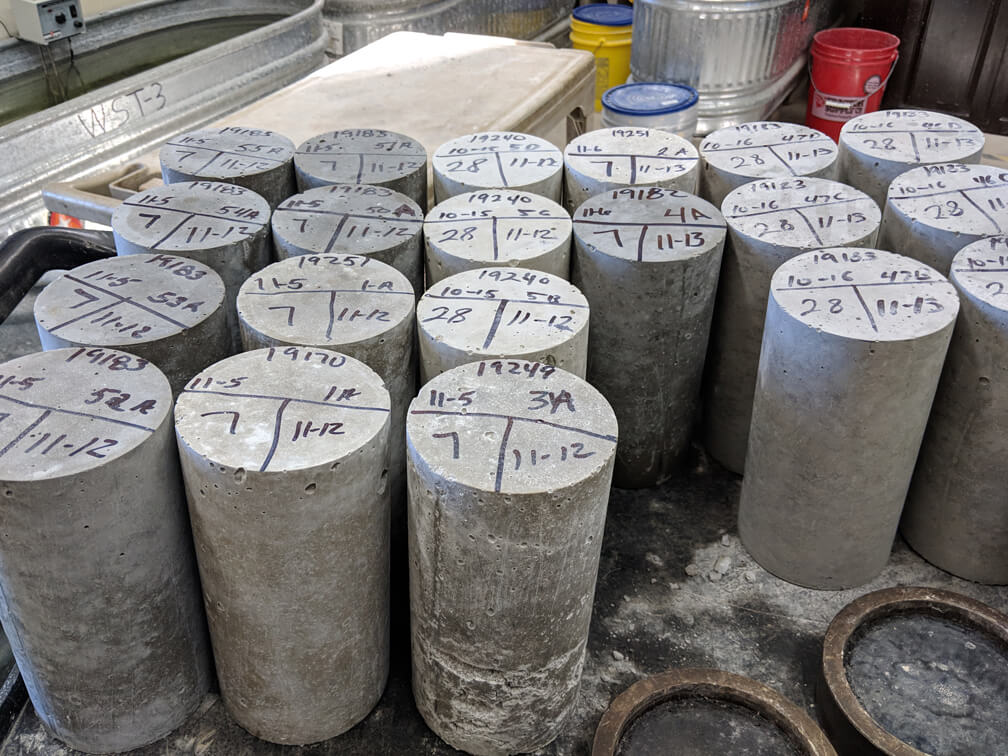The smart Trick of Material Testing Labs That Nobody is Discussing
Wiki Article
The Best Guide To Material Testing Labs
Table of ContentsSome Known Incorrect Statements About Material Testing Labs Examine This Report about Material Testing LabsThe 45-Second Trick For Material Testing LabsThe 45-Second Trick For Material Testing LabsThe Main Principles Of Material Testing Labs What Does Material Testing Labs Do?
Preliminary setting time is defined as the period as expiring between the time when water is contributed to the cement and the time at which the needle of 1 mm2 area falls short to pass through the examination block to a deepness of regarding 5 mm from all-time low of the mold and mildew.Various other tests performed on fresh concrete are: Segregation resistance, Unit weight, Wet evaluation, Temperature level, Heat generation, Bleeding The most common top quality examinations on solidified concrete are: The examination of compressive stamina of the concrete cube gives a suggestion concerning all the buildings or features of the concrete. The examination of tensile stamina of the concrete is just one of the standard & vital buildings which mostly impact the degree & size of breaking in structures.
It is required to establish the tensile strength of concrete to establish the load at which the concrete members might break. The modulus of flexibility of concrete is the ratio of tension to the pressure of the concrete under the application of lots.
The Basic Principles Of Material Testing Labs
As one of one of the most utilized materials in construction, concrete demands stringent top quality control to guarantee its stamina and also lasting efficiency. The strength will certainly depend on numerous elements, including water-cement ratio, quality of materials as well as quality assurance throughout the manufacturing of concrete. Below are three typical concrete tests that assist to ensure it meets the required standards and style specs for its usage.
In three layers, the cone is filled up with the fresh concrete example in an uniform fashion. Each layer is tamped with a steel pole to compact the concrete.
Material Testing Labs Can Be Fun For Everyone
The concrete needs to greatly retain its cone shape, demonstrating that the mix is natural, and also its workability isn't too high. The compressive stamina of concrete a common performance measure used by engineers to develop building and various other frameworks. Compressive stamina is specified as the capability of the concrete to stand up to certain compressive pressures.In a research laboratory, you can determine the compressive stamina of the concrete using highly controlled round moulds. How it functions Concrete examples are put into the cyndrical tubes gauging 200mm high and also 100mm in size (AS 1012. 9) on-site. When dried, claim the following day, they are then transported to the lab, de-moulded as well as put into a treating container.
Drying out shrinking takes place when the concrete structure agreements due to moisture/water loss. This can adversely affect the toughness, visual appeals, and use of concrete frameworks.
Not known Facts About Material Testing Labs
Exactly how it functions about his Examples are cast right into moulds and also stored in a moist environment until solidified. The concrete examples are after that de-moulded and also positioned in lime saturated water baths and after that a drying out chamber for the period of the examination. The initial analysis is determined at 7 days from time of spreading.Examining of the concrete plays a vital duty to understand the strength, resilience and condition of the structure. This article is regarding the types of Destructive and non-destructive examinations view website done on concrete.
Damaging tests and Non-Destructive examinations are done to figure out the essential residential properties of concrete like compressive stamina, flexural stamina, tensile strength etc. The harmful test of concrete assists to recognize the behaviour and also quality by damaging the test specimen at specific lots.
Not known Facts About Material Testing Labs
The devastating screening method is ideal as well as financially advantageous for the concrete specimens that are created at a huge scale. The major purpose of damaging tests is to examine the service life as well as find the weak point of layout that could not show under normal working conditions. It includes techniques where the concrete specimen is broken so as to identify mechanical homes i.
Quality control, Approval of concrete, Evaluation of curing, To give info on making use of sand and also aggregate. For assessing the harmony of concrete, Estimates the concrete high quality with typical requirements. To determine the consistent anxiety distribution. Investigating the practices of concrete. For identifying the in-place concrete stamina. material testing labs. Age of concrete, and so on.
These examinations identify the compressive, weblink flexural and also tensile stamina of concrete. There are different sorts of tests readily available to check out the solidified concrete. They are as complies with. Compressive strength of concrete is the ability of the concrete to withstand loads without breaking or contortion. The concrete specimen to perform this examination should be either round or cubic.
The relevant IS code for this examination is IS 516-1959. The load at which the sampling falls short determines its strength. The system of compressive toughness of concrete is N/mm2. The examination must be done at 7, 14 & 28 days. The splitting tensile strength test is just one of the tests on hardened concrete for establishing its tensile stamina.
Report this wiki page